Financial Resource Management and Decision Making Analysis
VerifiedAdded on 2020/02/05
|17
|5074
|100
Report
AI Summary
This report provides a comprehensive analysis of financial resource management, covering various aspects such as sources of finance, including equity, debt, and retained earnings, along with their advantages and disadvantages. It explores different types of business structures and their financial implications. The report delves into financial statements, including the statement of profit or loss, statement of financial position, and statement of cash flow, and their impact on key financial metrics. It also examines investment appraisal techniques like payback period and net present value (NPV), and recommends investment opportunities. The report further discusses working capital management, cash flow versus profit, and the importance of financial planning. Finally, it covers the interpretation of financial statements using ratio analysis, assessing the current performance of a company and highlighting the differences in financial statements. The report concludes with a discussion of the key findings and recommendations.
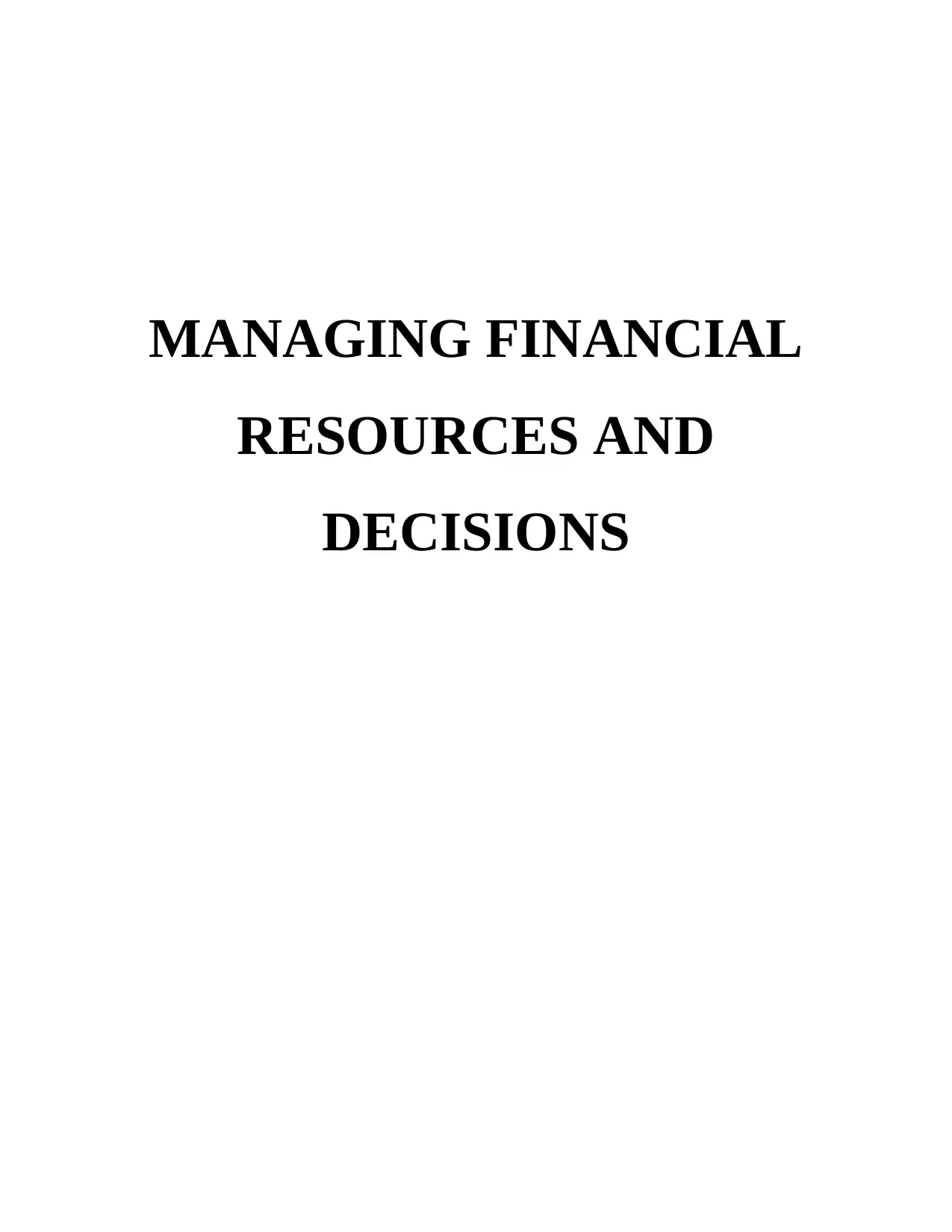
MANAGING FINANCIAL
RESOURCES AND
DECISIONS
RESOURCES AND
DECISIONS
Paraphrase This Document
Need a fresh take? Get an instant paraphrase of this document with our AI Paraphraser
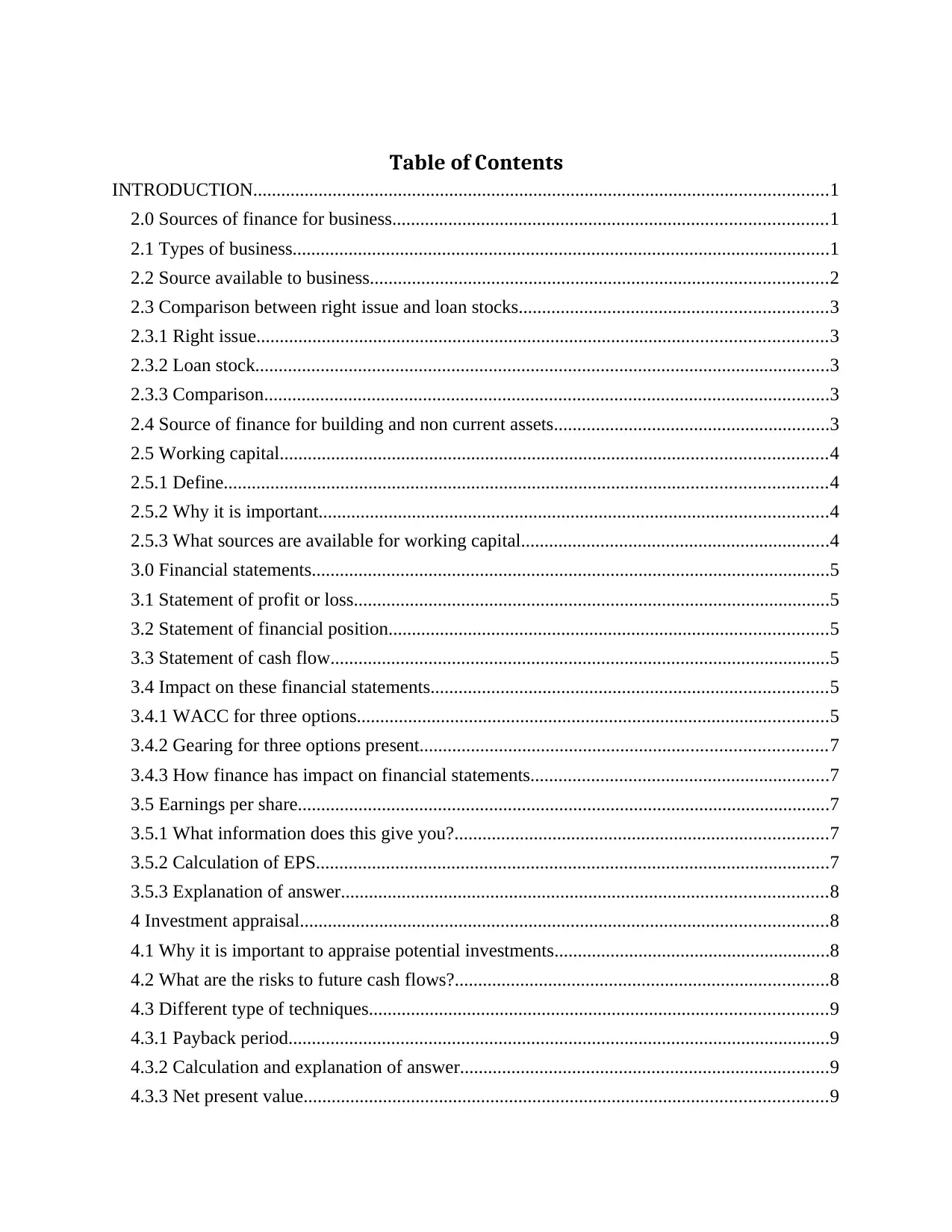
Table of Contents
INTRODUCTION...........................................................................................................................1
2.0 Sources of finance for business.............................................................................................1
2.1 Types of business...................................................................................................................1
2.2 Source available to business..................................................................................................2
2.3 Comparison between right issue and loan stocks..................................................................3
2.3.1 Right issue..........................................................................................................................3
2.3.2 Loan stock...........................................................................................................................3
2.3.3 Comparison.........................................................................................................................3
2.4 Source of finance for building and non current assets...........................................................3
2.5 Working capital.....................................................................................................................4
2.5.1 Define.................................................................................................................................4
2.5.2 Why it is important.............................................................................................................4
2.5.3 What sources are available for working capital..................................................................4
3.0 Financial statements...............................................................................................................5
3.1 Statement of profit or loss......................................................................................................5
3.2 Statement of financial position..............................................................................................5
3.3 Statement of cash flow...........................................................................................................5
3.4 Impact on these financial statements.....................................................................................5
3.4.1 WACC for three options.....................................................................................................5
3.4.2 Gearing for three options present.......................................................................................7
3.4.3 How finance has impact on financial statements................................................................7
3.5 Earnings per share..................................................................................................................7
3.5.1 What information does this give you?................................................................................7
3.5.2 Calculation of EPS..............................................................................................................7
3.5.3 Explanation of answer........................................................................................................8
4 Investment appraisal.................................................................................................................8
4.1 Why it is important to appraise potential investments...........................................................8
4.2 What are the risks to future cash flows?................................................................................8
4.3 Different type of techniques..................................................................................................9
4.3.1 Payback period....................................................................................................................9
4.3.2 Calculation and explanation of answer...............................................................................9
4.3.3 Net present value................................................................................................................9
INTRODUCTION...........................................................................................................................1
2.0 Sources of finance for business.............................................................................................1
2.1 Types of business...................................................................................................................1
2.2 Source available to business..................................................................................................2
2.3 Comparison between right issue and loan stocks..................................................................3
2.3.1 Right issue..........................................................................................................................3
2.3.2 Loan stock...........................................................................................................................3
2.3.3 Comparison.........................................................................................................................3
2.4 Source of finance for building and non current assets...........................................................3
2.5 Working capital.....................................................................................................................4
2.5.1 Define.................................................................................................................................4
2.5.2 Why it is important.............................................................................................................4
2.5.3 What sources are available for working capital..................................................................4
3.0 Financial statements...............................................................................................................5
3.1 Statement of profit or loss......................................................................................................5
3.2 Statement of financial position..............................................................................................5
3.3 Statement of cash flow...........................................................................................................5
3.4 Impact on these financial statements.....................................................................................5
3.4.1 WACC for three options.....................................................................................................5
3.4.2 Gearing for three options present.......................................................................................7
3.4.3 How finance has impact on financial statements................................................................7
3.5 Earnings per share..................................................................................................................7
3.5.1 What information does this give you?................................................................................7
3.5.2 Calculation of EPS..............................................................................................................7
3.5.3 Explanation of answer........................................................................................................8
4 Investment appraisal.................................................................................................................8
4.1 Why it is important to appraise potential investments...........................................................8
4.2 What are the risks to future cash flows?................................................................................8
4.3 Different type of techniques..................................................................................................9
4.3.1 Payback period....................................................................................................................9
4.3.2 Calculation and explanation of answer...............................................................................9
4.3.3 Net present value................................................................................................................9
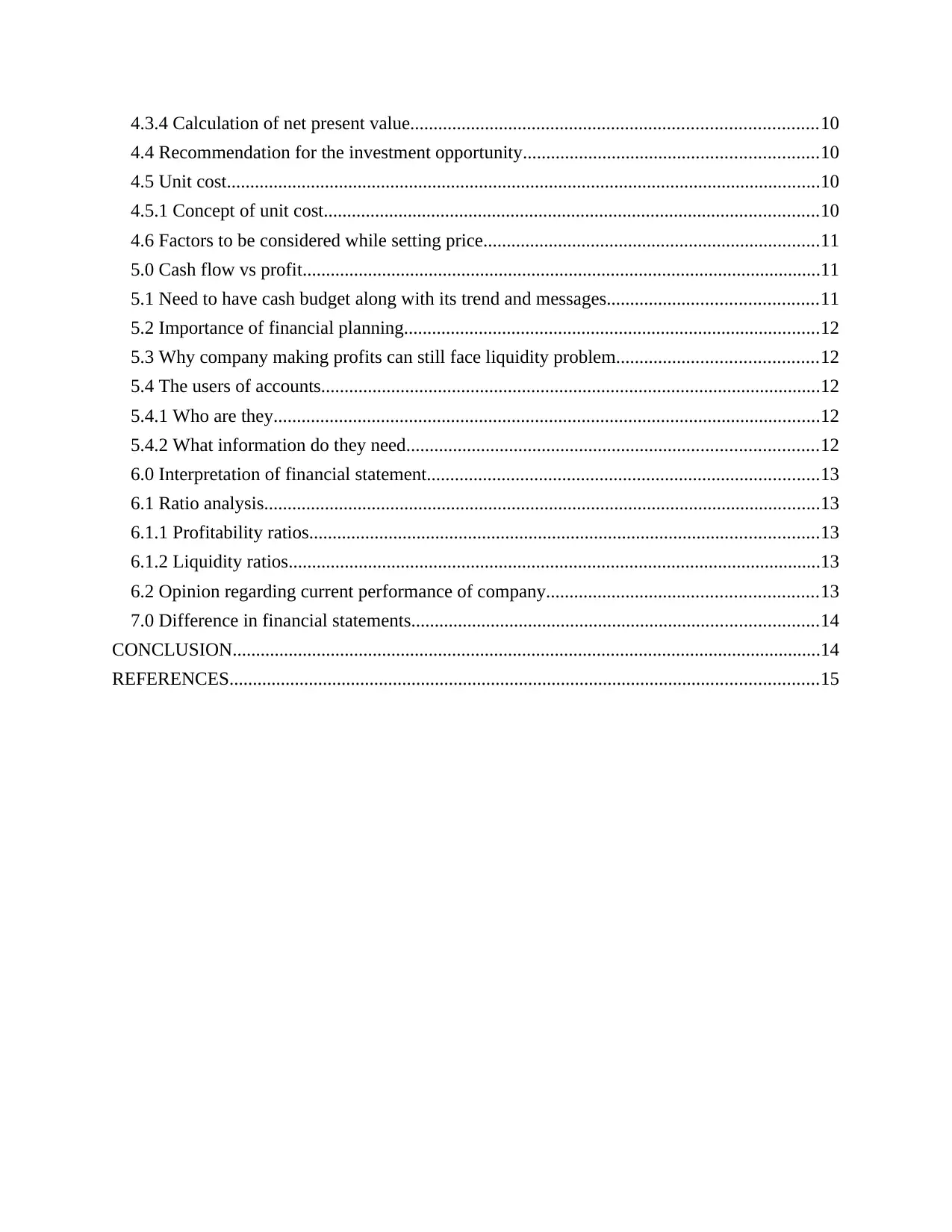
4.3.4 Calculation of net present value.......................................................................................10
4.4 Recommendation for the investment opportunity...............................................................10
4.5 Unit cost...............................................................................................................................10
4.5.1 Concept of unit cost..........................................................................................................10
4.6 Factors to be considered while setting price........................................................................11
5.0 Cash flow vs profit...............................................................................................................11
5.1 Need to have cash budget along with its trend and messages.............................................11
5.2 Importance of financial planning.........................................................................................12
5.3 Why company making profits can still face liquidity problem...........................................12
5.4 The users of accounts...........................................................................................................12
5.4.1 Who are they.....................................................................................................................12
5.4.2 What information do they need........................................................................................12
6.0 Interpretation of financial statement....................................................................................13
6.1 Ratio analysis.......................................................................................................................13
6.1.1 Profitability ratios.............................................................................................................13
6.1.2 Liquidity ratios..................................................................................................................13
6.2 Opinion regarding current performance of company..........................................................13
7.0 Difference in financial statements.......................................................................................14
CONCLUSION..............................................................................................................................14
REFERENCES..............................................................................................................................15
4.4 Recommendation for the investment opportunity...............................................................10
4.5 Unit cost...............................................................................................................................10
4.5.1 Concept of unit cost..........................................................................................................10
4.6 Factors to be considered while setting price........................................................................11
5.0 Cash flow vs profit...............................................................................................................11
5.1 Need to have cash budget along with its trend and messages.............................................11
5.2 Importance of financial planning.........................................................................................12
5.3 Why company making profits can still face liquidity problem...........................................12
5.4 The users of accounts...........................................................................................................12
5.4.1 Who are they.....................................................................................................................12
5.4.2 What information do they need........................................................................................12
6.0 Interpretation of financial statement....................................................................................13
6.1 Ratio analysis.......................................................................................................................13
6.1.1 Profitability ratios.............................................................................................................13
6.1.2 Liquidity ratios..................................................................................................................13
6.2 Opinion regarding current performance of company..........................................................13
7.0 Difference in financial statements.......................................................................................14
CONCLUSION..............................................................................................................................14
REFERENCES..............................................................................................................................15
⊘ This is a preview!⊘
Do you want full access?
Subscribe today to unlock all pages.

Trusted by 1+ million students worldwide
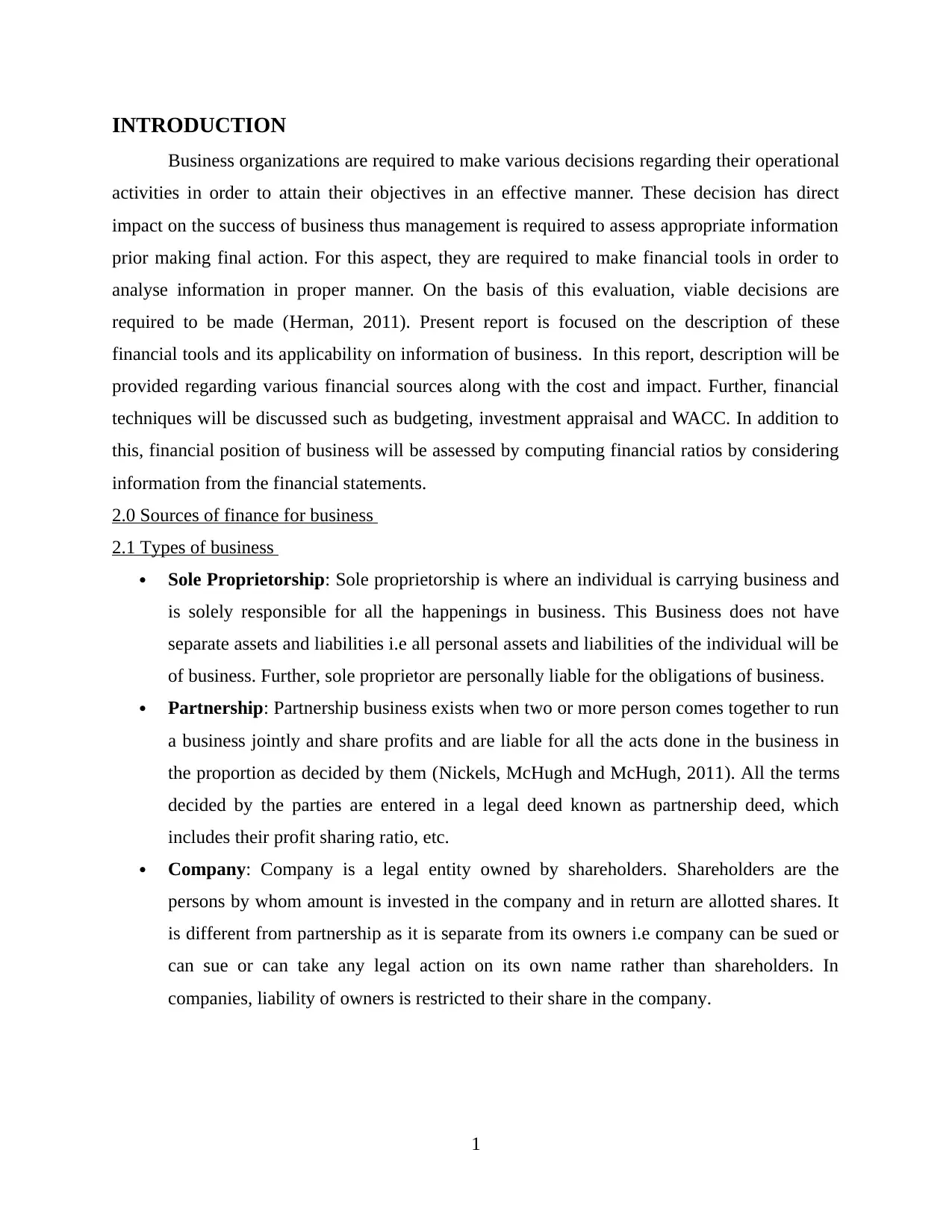
INTRODUCTION
Business organizations are required to make various decisions regarding their operational
activities in order to attain their objectives in an effective manner. These decision has direct
impact on the success of business thus management is required to assess appropriate information
prior making final action. For this aspect, they are required to make financial tools in order to
analyse information in proper manner. On the basis of this evaluation, viable decisions are
required to be made (Herman, 2011). Present report is focused on the description of these
financial tools and its applicability on information of business. In this report, description will be
provided regarding various financial sources along with the cost and impact. Further, financial
techniques will be discussed such as budgeting, investment appraisal and WACC. In addition to
this, financial position of business will be assessed by computing financial ratios by considering
information from the financial statements.
2.0 Sources of finance for business
2.1 Types of business
Sole Proprietorship: Sole proprietorship is where an individual is carrying business and
is solely responsible for all the happenings in business. This Business does not have
separate assets and liabilities i.e all personal assets and liabilities of the individual will be
of business. Further, sole proprietor are personally liable for the obligations of business.
Partnership: Partnership business exists when two or more person comes together to run
a business jointly and share profits and are liable for all the acts done in the business in
the proportion as decided by them (Nickels, McHugh and McHugh, 2011). All the terms
decided by the parties are entered in a legal deed known as partnership deed, which
includes their profit sharing ratio, etc.
Company: Company is a legal entity owned by shareholders. Shareholders are the
persons by whom amount is invested in the company and in return are allotted shares. It
is different from partnership as it is separate from its owners i.e company can be sued or
can sue or can take any legal action on its own name rather than shareholders. In
companies, liability of owners is restricted to their share in the company.
1
Business organizations are required to make various decisions regarding their operational
activities in order to attain their objectives in an effective manner. These decision has direct
impact on the success of business thus management is required to assess appropriate information
prior making final action. For this aspect, they are required to make financial tools in order to
analyse information in proper manner. On the basis of this evaluation, viable decisions are
required to be made (Herman, 2011). Present report is focused on the description of these
financial tools and its applicability on information of business. In this report, description will be
provided regarding various financial sources along with the cost and impact. Further, financial
techniques will be discussed such as budgeting, investment appraisal and WACC. In addition to
this, financial position of business will be assessed by computing financial ratios by considering
information from the financial statements.
2.0 Sources of finance for business
2.1 Types of business
Sole Proprietorship: Sole proprietorship is where an individual is carrying business and
is solely responsible for all the happenings in business. This Business does not have
separate assets and liabilities i.e all personal assets and liabilities of the individual will be
of business. Further, sole proprietor are personally liable for the obligations of business.
Partnership: Partnership business exists when two or more person comes together to run
a business jointly and share profits and are liable for all the acts done in the business in
the proportion as decided by them (Nickels, McHugh and McHugh, 2011). All the terms
decided by the parties are entered in a legal deed known as partnership deed, which
includes their profit sharing ratio, etc.
Company: Company is a legal entity owned by shareholders. Shareholders are the
persons by whom amount is invested in the company and in return are allotted shares. It
is different from partnership as it is separate from its owners i.e company can be sued or
can sue or can take any legal action on its own name rather than shareholders. In
companies, liability of owners is restricted to their share in the company.
1
Paraphrase This Document
Need a fresh take? Get an instant paraphrase of this document with our AI Paraphraser
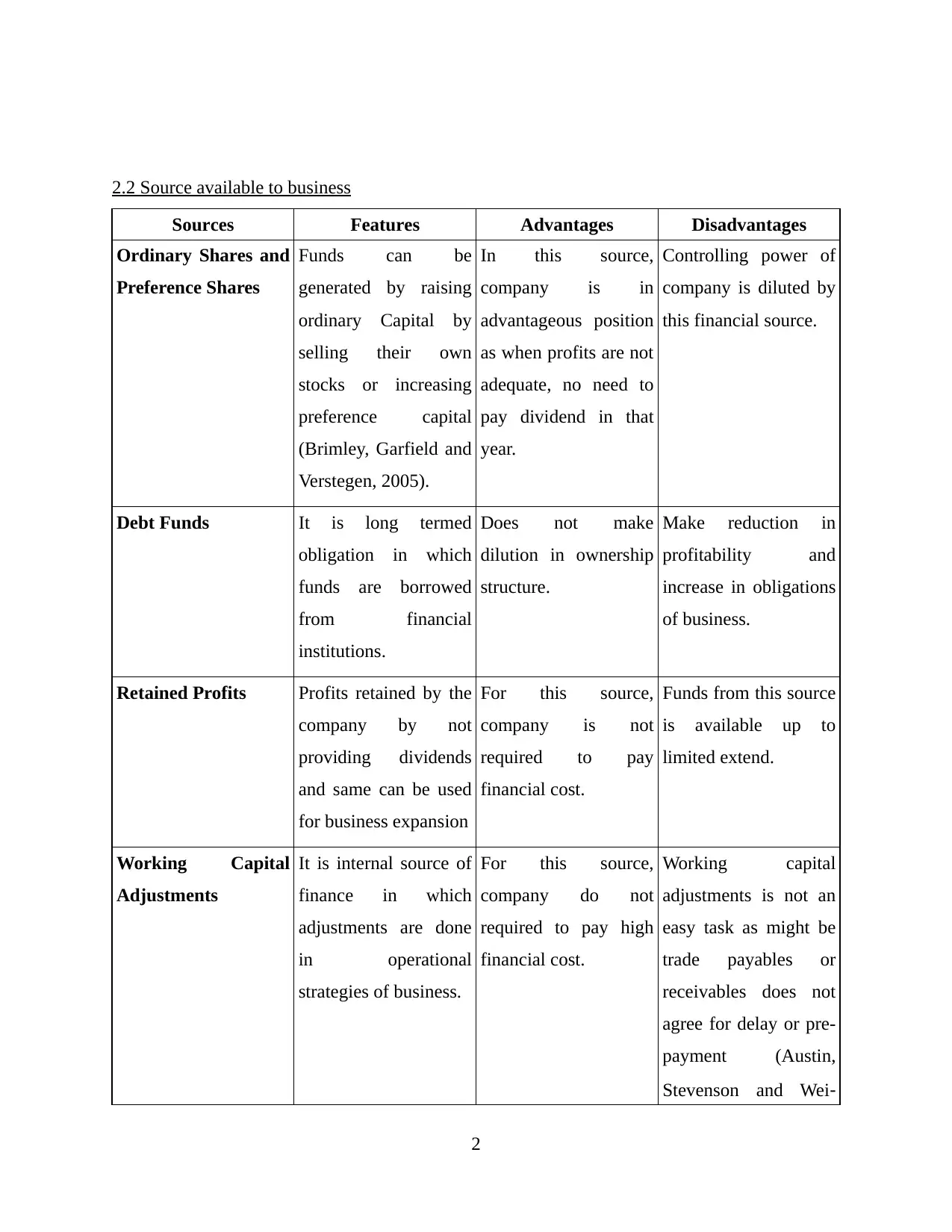
2.2 Source available to business
Sources Features Advantages Disadvantages
Ordinary Shares and
Preference Shares
Funds can be
generated by raising
ordinary Capital by
selling their own
stocks or increasing
preference capital
(Brimley, Garfield and
Verstegen, 2005).
In this source,
company is in
advantageous position
as when profits are not
adequate, no need to
pay dividend in that
year.
Controlling power of
company is diluted by
this financial source.
Debt Funds It is long termed
obligation in which
funds are borrowed
from financial
institutions.
Does not make
dilution in ownership
structure.
Make reduction in
profitability and
increase in obligations
of business.
Retained Profits Profits retained by the
company by not
providing dividends
and same can be used
for business expansion
For this source,
company is not
required to pay
financial cost.
Funds from this source
is available up to
limited extend.
Working Capital
Adjustments
It is internal source of
finance in which
adjustments are done
in operational
strategies of business.
For this source,
company do not
required to pay high
financial cost.
Working capital
adjustments is not an
easy task as might be
trade payables or
receivables does not
agree for delay or pre-
payment (Austin,
Stevenson and Wei‐
2
Sources Features Advantages Disadvantages
Ordinary Shares and
Preference Shares
Funds can be
generated by raising
ordinary Capital by
selling their own
stocks or increasing
preference capital
(Brimley, Garfield and
Verstegen, 2005).
In this source,
company is in
advantageous position
as when profits are not
adequate, no need to
pay dividend in that
year.
Controlling power of
company is diluted by
this financial source.
Debt Funds It is long termed
obligation in which
funds are borrowed
from financial
institutions.
Does not make
dilution in ownership
structure.
Make reduction in
profitability and
increase in obligations
of business.
Retained Profits Profits retained by the
company by not
providing dividends
and same can be used
for business expansion
For this source,
company is not
required to pay
financial cost.
Funds from this source
is available up to
limited extend.
Working Capital
Adjustments
It is internal source of
finance in which
adjustments are done
in operational
strategies of business.
For this source,
company do not
required to pay high
financial cost.
Working capital
adjustments is not an
easy task as might be
trade payables or
receivables does not
agree for delay or pre-
payment (Austin,
Stevenson and Wei‐
2
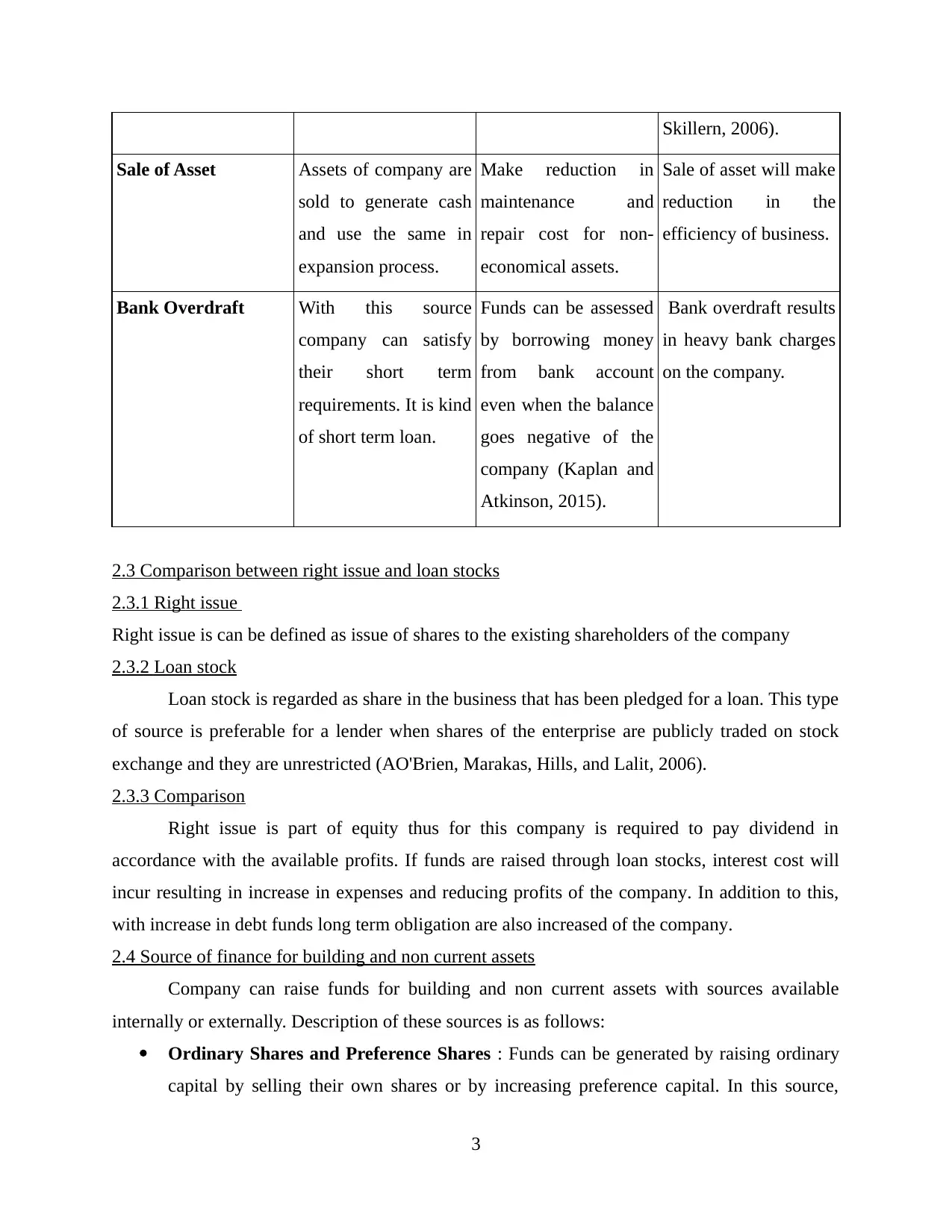
Skillern, 2006).
Sale of Asset Assets of company are
sold to generate cash
and use the same in
expansion process.
Make reduction in
maintenance and
repair cost for non-
economical assets.
Sale of asset will make
reduction in the
efficiency of business.
Bank Overdraft With this source
company can satisfy
their short term
requirements. It is kind
of short term loan.
Funds can be assessed
by borrowing money
from bank account
even when the balance
goes negative of the
company (Kaplan and
Atkinson, 2015).
Bank overdraft results
in heavy bank charges
on the company.
2.3 Comparison between right issue and loan stocks
2.3.1 Right issue
Right issue is can be defined as issue of shares to the existing shareholders of the company
2.3.2 Loan stock
Loan stock is regarded as share in the business that has been pledged for a loan. This type
of source is preferable for a lender when shares of the enterprise are publicly traded on stock
exchange and they are unrestricted (AO'Brien, Marakas, Hills, and Lalit, 2006).
2.3.3 Comparison
Right issue is part of equity thus for this company is required to pay dividend in
accordance with the available profits. If funds are raised through loan stocks, interest cost will
incur resulting in increase in expenses and reducing profits of the company. In addition to this,
with increase in debt funds long term obligation are also increased of the company.
2.4 Source of finance for building and non current assets
Company can raise funds for building and non current assets with sources available
internally or externally. Description of these sources is as follows:
Ordinary Shares and Preference Shares : Funds can be generated by raising ordinary
capital by selling their own shares or by increasing preference capital. In this source,
3
Sale of Asset Assets of company are
sold to generate cash
and use the same in
expansion process.
Make reduction in
maintenance and
repair cost for non-
economical assets.
Sale of asset will make
reduction in the
efficiency of business.
Bank Overdraft With this source
company can satisfy
their short term
requirements. It is kind
of short term loan.
Funds can be assessed
by borrowing money
from bank account
even when the balance
goes negative of the
company (Kaplan and
Atkinson, 2015).
Bank overdraft results
in heavy bank charges
on the company.
2.3 Comparison between right issue and loan stocks
2.3.1 Right issue
Right issue is can be defined as issue of shares to the existing shareholders of the company
2.3.2 Loan stock
Loan stock is regarded as share in the business that has been pledged for a loan. This type
of source is preferable for a lender when shares of the enterprise are publicly traded on stock
exchange and they are unrestricted (AO'Brien, Marakas, Hills, and Lalit, 2006).
2.3.3 Comparison
Right issue is part of equity thus for this company is required to pay dividend in
accordance with the available profits. If funds are raised through loan stocks, interest cost will
incur resulting in increase in expenses and reducing profits of the company. In addition to this,
with increase in debt funds long term obligation are also increased of the company.
2.4 Source of finance for building and non current assets
Company can raise funds for building and non current assets with sources available
internally or externally. Description of these sources is as follows:
Ordinary Shares and Preference Shares : Funds can be generated by raising ordinary
capital by selling their own shares or by increasing preference capital. In this source,
3
⊘ This is a preview!⊘
Do you want full access?
Subscribe today to unlock all pages.

Trusted by 1+ million students worldwide
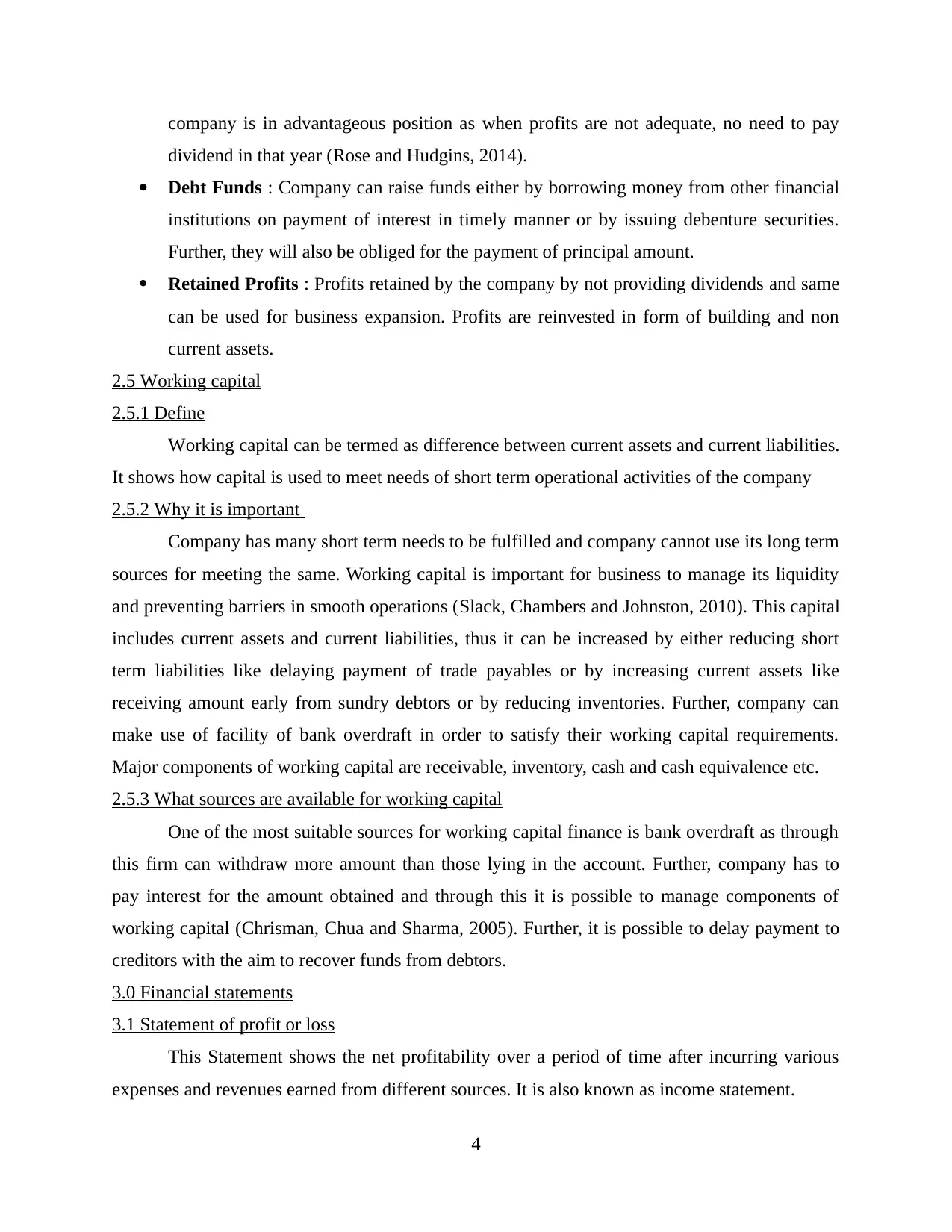
company is in advantageous position as when profits are not adequate, no need to pay
dividend in that year (Rose and Hudgins, 2014).
Debt Funds : Company can raise funds either by borrowing money from other financial
institutions on payment of interest in timely manner or by issuing debenture securities.
Further, they will also be obliged for the payment of principal amount.
Retained Profits : Profits retained by the company by not providing dividends and same
can be used for business expansion. Profits are reinvested in form of building and non
current assets.
2.5 Working capital
2.5.1 Define
Working capital can be termed as difference between current assets and current liabilities.
It shows how capital is used to meet needs of short term operational activities of the company
2.5.2 Why it is important
Company has many short term needs to be fulfilled and company cannot use its long term
sources for meeting the same. Working capital is important for business to manage its liquidity
and preventing barriers in smooth operations (Slack, Chambers and Johnston, 2010). This capital
includes current assets and current liabilities, thus it can be increased by either reducing short
term liabilities like delaying payment of trade payables or by increasing current assets like
receiving amount early from sundry debtors or by reducing inventories. Further, company can
make use of facility of bank overdraft in order to satisfy their working capital requirements.
Major components of working capital are receivable, inventory, cash and cash equivalence etc.
2.5.3 What sources are available for working capital
One of the most suitable sources for working capital finance is bank overdraft as through
this firm can withdraw more amount than those lying in the account. Further, company has to
pay interest for the amount obtained and through this it is possible to manage components of
working capital (Chrisman, Chua and Sharma, 2005). Further, it is possible to delay payment to
creditors with the aim to recover funds from debtors.
3.0 Financial statements
3.1 Statement of profit or loss
This Statement shows the net profitability over a period of time after incurring various
expenses and revenues earned from different sources. It is also known as income statement.
4
dividend in that year (Rose and Hudgins, 2014).
Debt Funds : Company can raise funds either by borrowing money from other financial
institutions on payment of interest in timely manner or by issuing debenture securities.
Further, they will also be obliged for the payment of principal amount.
Retained Profits : Profits retained by the company by not providing dividends and same
can be used for business expansion. Profits are reinvested in form of building and non
current assets.
2.5 Working capital
2.5.1 Define
Working capital can be termed as difference between current assets and current liabilities.
It shows how capital is used to meet needs of short term operational activities of the company
2.5.2 Why it is important
Company has many short term needs to be fulfilled and company cannot use its long term
sources for meeting the same. Working capital is important for business to manage its liquidity
and preventing barriers in smooth operations (Slack, Chambers and Johnston, 2010). This capital
includes current assets and current liabilities, thus it can be increased by either reducing short
term liabilities like delaying payment of trade payables or by increasing current assets like
receiving amount early from sundry debtors or by reducing inventories. Further, company can
make use of facility of bank overdraft in order to satisfy their working capital requirements.
Major components of working capital are receivable, inventory, cash and cash equivalence etc.
2.5.3 What sources are available for working capital
One of the most suitable sources for working capital finance is bank overdraft as through
this firm can withdraw more amount than those lying in the account. Further, company has to
pay interest for the amount obtained and through this it is possible to manage components of
working capital (Chrisman, Chua and Sharma, 2005). Further, it is possible to delay payment to
creditors with the aim to recover funds from debtors.
3.0 Financial statements
3.1 Statement of profit or loss
This Statement shows the net profitability over a period of time after incurring various
expenses and revenues earned from different sources. It is also known as income statement.
4
Paraphrase This Document
Need a fresh take? Get an instant paraphrase of this document with our AI Paraphraser
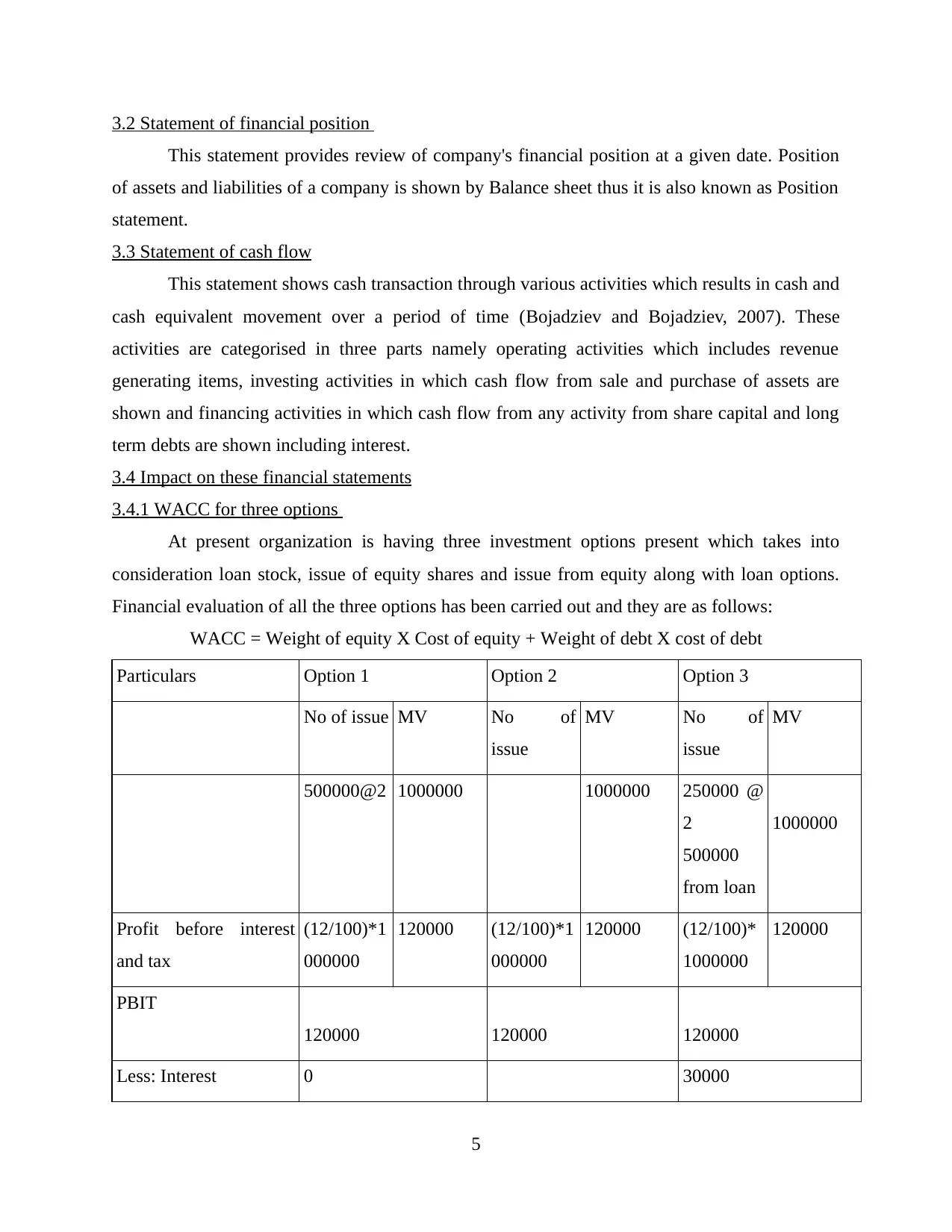
3.2 Statement of financial position
This statement provides review of company's financial position at a given date. Position
of assets and liabilities of a company is shown by Balance sheet thus it is also known as Position
statement.
3.3 Statement of cash flow
This statement shows cash transaction through various activities which results in cash and
cash equivalent movement over a period of time (Bojadziev and Bojadziev, 2007). These
activities are categorised in three parts namely operating activities which includes revenue
generating items, investing activities in which cash flow from sale and purchase of assets are
shown and financing activities in which cash flow from any activity from share capital and long
term debts are shown including interest.
3.4 Impact on these financial statements
3.4.1 WACC for three options
At present organization is having three investment options present which takes into
consideration loan stock, issue of equity shares and issue from equity along with loan options.
Financial evaluation of all the three options has been carried out and they are as follows:
WACC = Weight of equity X Cost of equity + Weight of debt X cost of debt
Particulars Option 1 Option 2 Option 3
No of issue MV No of
issue
MV No of
issue
MV
500000@2 1000000 1000000 250000 @
2
500000
from loan
1000000
Profit before interest
and tax
(12/100)*1
000000
120000 (12/100)*1
000000
120000 (12/100)*
1000000
120000
PBIT
120000 120000 120000
Less: Interest 0 30000
5
This statement provides review of company's financial position at a given date. Position
of assets and liabilities of a company is shown by Balance sheet thus it is also known as Position
statement.
3.3 Statement of cash flow
This statement shows cash transaction through various activities which results in cash and
cash equivalent movement over a period of time (Bojadziev and Bojadziev, 2007). These
activities are categorised in three parts namely operating activities which includes revenue
generating items, investing activities in which cash flow from sale and purchase of assets are
shown and financing activities in which cash flow from any activity from share capital and long
term debts are shown including interest.
3.4 Impact on these financial statements
3.4.1 WACC for three options
At present organization is having three investment options present which takes into
consideration loan stock, issue of equity shares and issue from equity along with loan options.
Financial evaluation of all the three options has been carried out and they are as follows:
WACC = Weight of equity X Cost of equity + Weight of debt X cost of debt
Particulars Option 1 Option 2 Option 3
No of issue MV No of
issue
MV No of
issue
MV
500000@2 1000000 1000000 250000 @
2
500000
from loan
1000000
Profit before interest
and tax
(12/100)*1
000000
120000 (12/100)*1
000000
120000 (12/100)*
1000000
120000
PBIT
120000 120000 120000
Less: Interest 0 30000
5
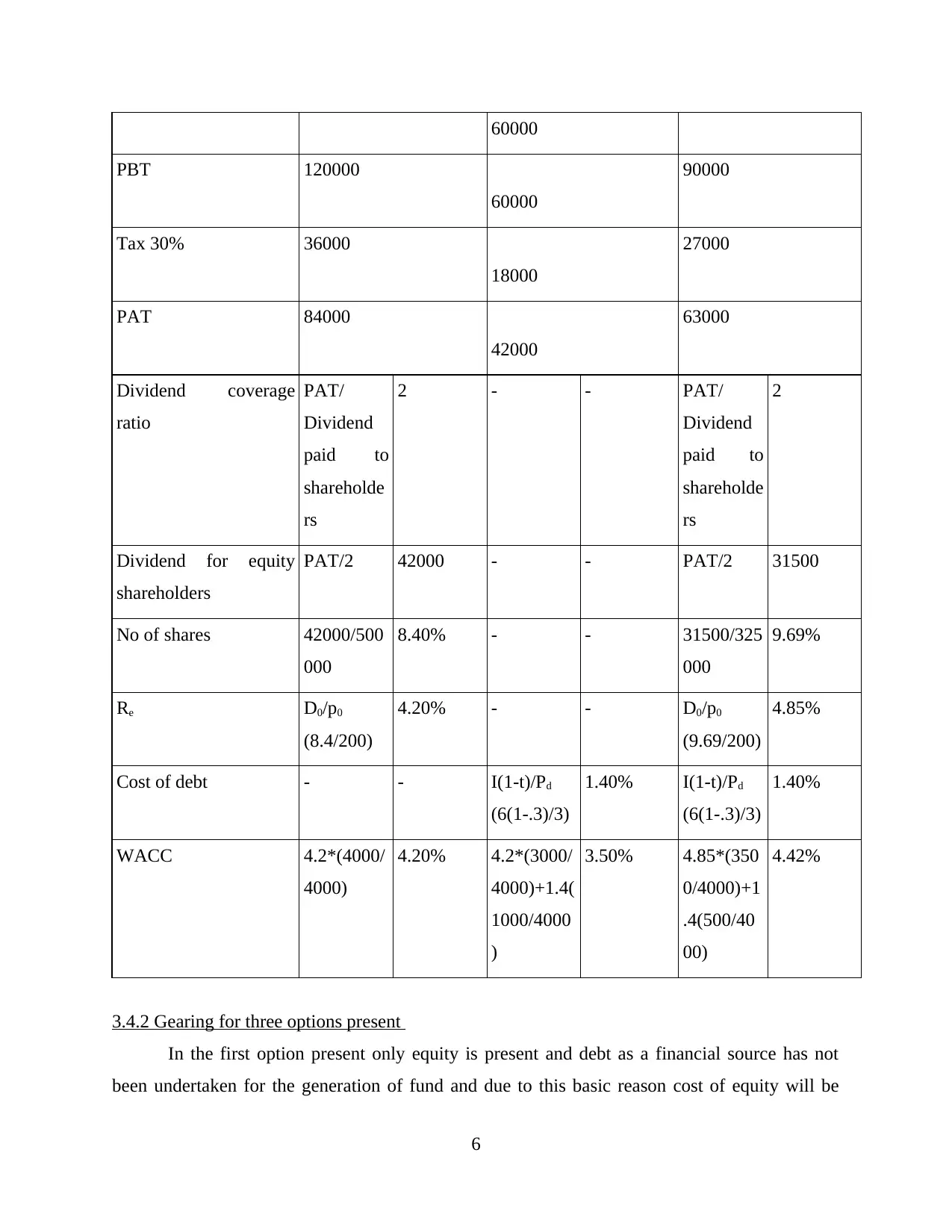
60000
PBT 120000
60000
90000
Tax 30% 36000
18000
27000
PAT 84000
42000
63000
Dividend coverage
ratio
PAT/
Dividend
paid to
shareholde
rs
2 - - PAT/
Dividend
paid to
shareholde
rs
2
Dividend for equity
shareholders
PAT/2 42000 - - PAT/2 31500
No of shares 42000/500
000
8.40% - - 31500/325
000
9.69%
Re D0/p0
(8.4/200)
4.20% - - D0/p0
(9.69/200)
4.85%
Cost of debt - - I(1-t)/Pd
(6(1-.3)/3)
1.40% I(1-t)/Pd
(6(1-.3)/3)
1.40%
WACC 4.2*(4000/
4000)
4.20% 4.2*(3000/
4000)+1.4(
1000/4000
)
3.50% 4.85*(350
0/4000)+1
.4(500/40
00)
4.42%
3.4.2 Gearing for three options present
In the first option present only equity is present and debt as a financial source has not
been undertaken for the generation of fund and due to this basic reason cost of equity will be
6
PBT 120000
60000
90000
Tax 30% 36000
18000
27000
PAT 84000
42000
63000
Dividend coverage
ratio
PAT/
Dividend
paid to
shareholde
rs
2 - - PAT/
Dividend
paid to
shareholde
rs
2
Dividend for equity
shareholders
PAT/2 42000 - - PAT/2 31500
No of shares 42000/500
000
8.40% - - 31500/325
000
9.69%
Re D0/p0
(8.4/200)
4.20% - - D0/p0
(9.69/200)
4.85%
Cost of debt - - I(1-t)/Pd
(6(1-.3)/3)
1.40% I(1-t)/Pd
(6(1-.3)/3)
1.40%
WACC 4.2*(4000/
4000)
4.20% 4.2*(3000/
4000)+1.4(
1000/4000
)
3.50% 4.85*(350
0/4000)+1
.4(500/40
00)
4.42%
3.4.2 Gearing for three options present
In the first option present only equity is present and debt as a financial source has not
been undertaken for the generation of fund and due to this basic reason cost of equity will be
6
⊘ This is a preview!⊘
Do you want full access?
Subscribe today to unlock all pages.

Trusted by 1+ million students worldwide
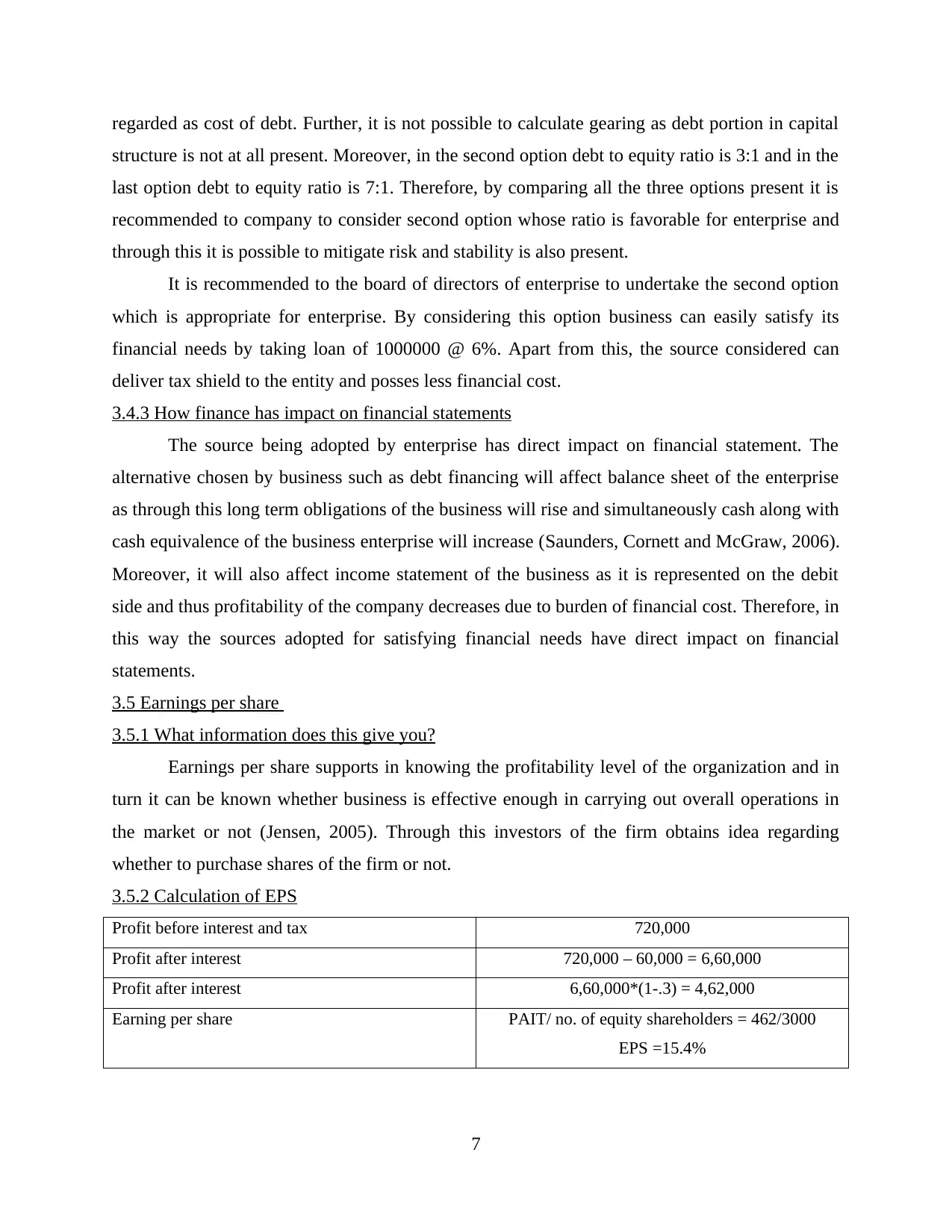
regarded as cost of debt. Further, it is not possible to calculate gearing as debt portion in capital
structure is not at all present. Moreover, in the second option debt to equity ratio is 3:1 and in the
last option debt to equity ratio is 7:1. Therefore, by comparing all the three options present it is
recommended to company to consider second option whose ratio is favorable for enterprise and
through this it is possible to mitigate risk and stability is also present.
It is recommended to the board of directors of enterprise to undertake the second option
which is appropriate for enterprise. By considering this option business can easily satisfy its
financial needs by taking loan of 1000000 @ 6%. Apart from this, the source considered can
deliver tax shield to the entity and posses less financial cost.
3.4.3 How finance has impact on financial statements
The source being adopted by enterprise has direct impact on financial statement. The
alternative chosen by business such as debt financing will affect balance sheet of the enterprise
as through this long term obligations of the business will rise and simultaneously cash along with
cash equivalence of the business enterprise will increase (Saunders, Cornett and McGraw, 2006).
Moreover, it will also affect income statement of the business as it is represented on the debit
side and thus profitability of the company decreases due to burden of financial cost. Therefore, in
this way the sources adopted for satisfying financial needs have direct impact on financial
statements.
3.5 Earnings per share
3.5.1 What information does this give you?
Earnings per share supports in knowing the profitability level of the organization and in
turn it can be known whether business is effective enough in carrying out overall operations in
the market or not (Jensen, 2005). Through this investors of the firm obtains idea regarding
whether to purchase shares of the firm or not.
3.5.2 Calculation of EPS
Profit before interest and tax 720,000
Profit after interest 720,000 – 60,000 = 6,60,000
Profit after interest 6,60,000*(1-.3) = 4,62,000
Earning per share PAIT/ no. of equity shareholders = 462/3000
EPS =15.4%
7
structure is not at all present. Moreover, in the second option debt to equity ratio is 3:1 and in the
last option debt to equity ratio is 7:1. Therefore, by comparing all the three options present it is
recommended to company to consider second option whose ratio is favorable for enterprise and
through this it is possible to mitigate risk and stability is also present.
It is recommended to the board of directors of enterprise to undertake the second option
which is appropriate for enterprise. By considering this option business can easily satisfy its
financial needs by taking loan of 1000000 @ 6%. Apart from this, the source considered can
deliver tax shield to the entity and posses less financial cost.
3.4.3 How finance has impact on financial statements
The source being adopted by enterprise has direct impact on financial statement. The
alternative chosen by business such as debt financing will affect balance sheet of the enterprise
as through this long term obligations of the business will rise and simultaneously cash along with
cash equivalence of the business enterprise will increase (Saunders, Cornett and McGraw, 2006).
Moreover, it will also affect income statement of the business as it is represented on the debit
side and thus profitability of the company decreases due to burden of financial cost. Therefore, in
this way the sources adopted for satisfying financial needs have direct impact on financial
statements.
3.5 Earnings per share
3.5.1 What information does this give you?
Earnings per share supports in knowing the profitability level of the organization and in
turn it can be known whether business is effective enough in carrying out overall operations in
the market or not (Jensen, 2005). Through this investors of the firm obtains idea regarding
whether to purchase shares of the firm or not.
3.5.2 Calculation of EPS
Profit before interest and tax 720,000
Profit after interest 720,000 – 60,000 = 6,60,000
Profit after interest 6,60,000*(1-.3) = 4,62,000
Earning per share PAIT/ no. of equity shareholders = 462/3000
EPS =15.4%
7
Paraphrase This Document
Need a fresh take? Get an instant paraphrase of this document with our AI Paraphraser
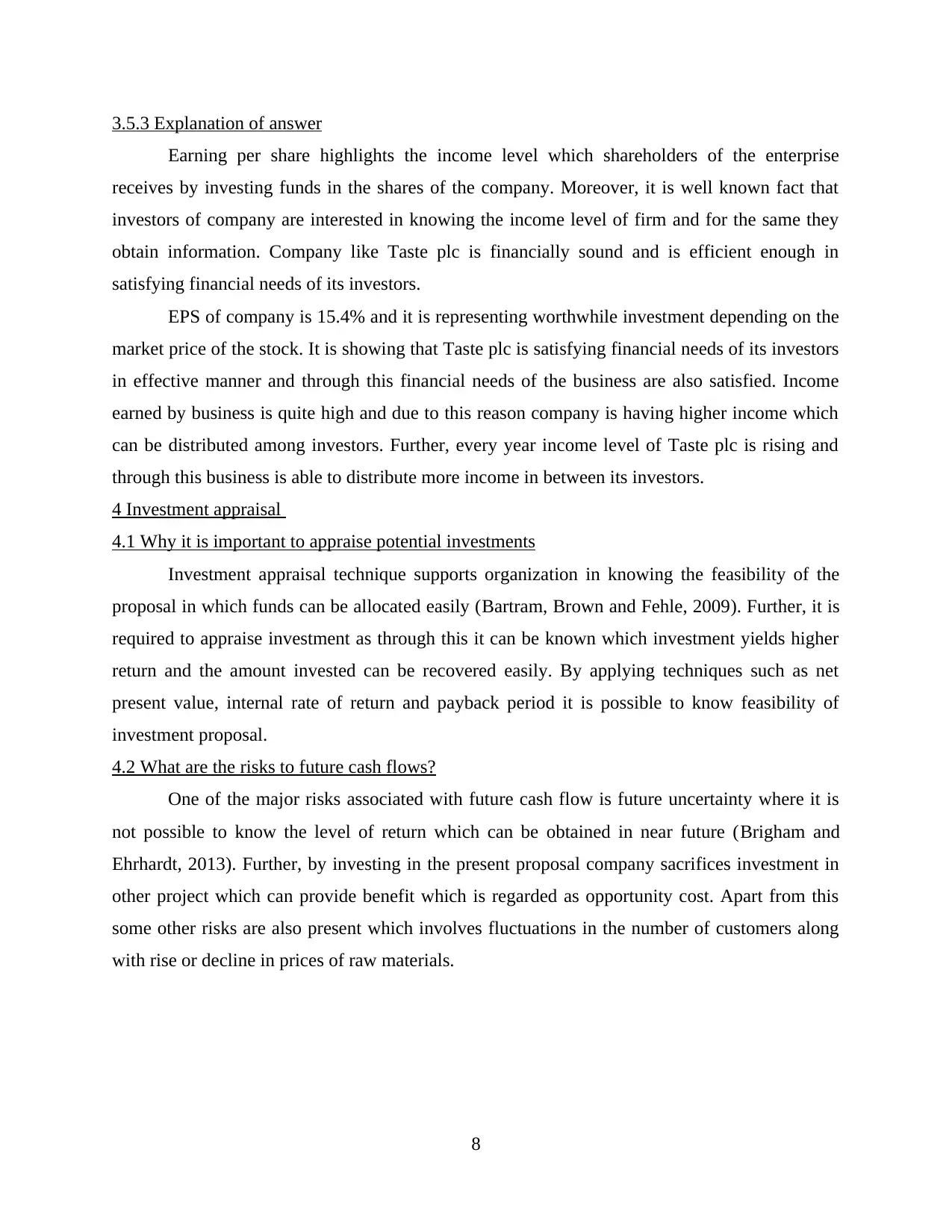
3.5.3 Explanation of answer
Earning per share highlights the income level which shareholders of the enterprise
receives by investing funds in the shares of the company. Moreover, it is well known fact that
investors of company are interested in knowing the income level of firm and for the same they
obtain information. Company like Taste plc is financially sound and is efficient enough in
satisfying financial needs of its investors.
EPS of company is 15.4% and it is representing worthwhile investment depending on the
market price of the stock. It is showing that Taste plc is satisfying financial needs of its investors
in effective manner and through this financial needs of the business are also satisfied. Income
earned by business is quite high and due to this reason company is having higher income which
can be distributed among investors. Further, every year income level of Taste plc is rising and
through this business is able to distribute more income in between its investors.
4 Investment appraisal
4.1 Why it is important to appraise potential investments
Investment appraisal technique supports organization in knowing the feasibility of the
proposal in which funds can be allocated easily (Bartram, Brown and Fehle, 2009). Further, it is
required to appraise investment as through this it can be known which investment yields higher
return and the amount invested can be recovered easily. By applying techniques such as net
present value, internal rate of return and payback period it is possible to know feasibility of
investment proposal.
4.2 What are the risks to future cash flows?
One of the major risks associated with future cash flow is future uncertainty where it is
not possible to know the level of return which can be obtained in near future (Brigham and
Ehrhardt, 2013). Further, by investing in the present proposal company sacrifices investment in
other project which can provide benefit which is regarded as opportunity cost. Apart from this
some other risks are also present which involves fluctuations in the number of customers along
with rise or decline in prices of raw materials.
8
Earning per share highlights the income level which shareholders of the enterprise
receives by investing funds in the shares of the company. Moreover, it is well known fact that
investors of company are interested in knowing the income level of firm and for the same they
obtain information. Company like Taste plc is financially sound and is efficient enough in
satisfying financial needs of its investors.
EPS of company is 15.4% and it is representing worthwhile investment depending on the
market price of the stock. It is showing that Taste plc is satisfying financial needs of its investors
in effective manner and through this financial needs of the business are also satisfied. Income
earned by business is quite high and due to this reason company is having higher income which
can be distributed among investors. Further, every year income level of Taste plc is rising and
through this business is able to distribute more income in between its investors.
4 Investment appraisal
4.1 Why it is important to appraise potential investments
Investment appraisal technique supports organization in knowing the feasibility of the
proposal in which funds can be allocated easily (Bartram, Brown and Fehle, 2009). Further, it is
required to appraise investment as through this it can be known which investment yields higher
return and the amount invested can be recovered easily. By applying techniques such as net
present value, internal rate of return and payback period it is possible to know feasibility of
investment proposal.
4.2 What are the risks to future cash flows?
One of the major risks associated with future cash flow is future uncertainty where it is
not possible to know the level of return which can be obtained in near future (Brigham and
Ehrhardt, 2013). Further, by investing in the present proposal company sacrifices investment in
other project which can provide benefit which is regarded as opportunity cost. Apart from this
some other risks are also present which involves fluctuations in the number of customers along
with rise or decline in prices of raw materials.
8
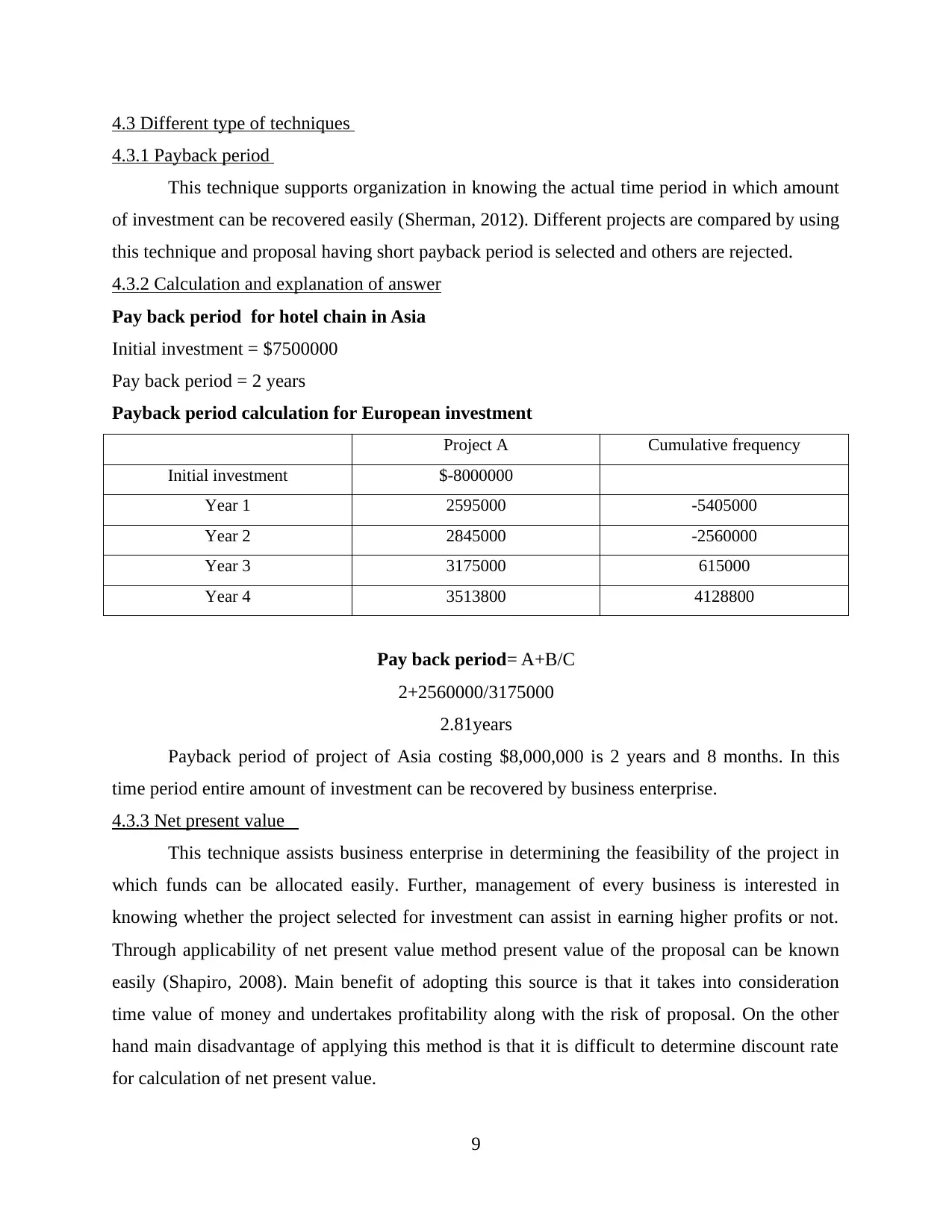
4.3 Different type of techniques
4.3.1 Payback period
This technique supports organization in knowing the actual time period in which amount
of investment can be recovered easily (Sherman, 2012). Different projects are compared by using
this technique and proposal having short payback period is selected and others are rejected.
4.3.2 Calculation and explanation of answer
Pay back period for hotel chain in Asia
Initial investment = $7500000
Pay back period = 2 years
Payback period calculation for European investment
Project A Cumulative frequency
Initial investment $-8000000
Year 1 2595000 -5405000
Year 2 2845000 -2560000
Year 3 3175000 615000
Year 4 3513800 4128800
Pay back period= A+B/C
2+2560000/3175000
2.81years
Payback period of project of Asia costing $8,000,000 is 2 years and 8 months. In this
time period entire amount of investment can be recovered by business enterprise.
4.3.3 Net present value
This technique assists business enterprise in determining the feasibility of the project in
which funds can be allocated easily. Further, management of every business is interested in
knowing whether the project selected for investment can assist in earning higher profits or not.
Through applicability of net present value method present value of the proposal can be known
easily (Shapiro, 2008). Main benefit of adopting this source is that it takes into consideration
time value of money and undertakes profitability along with the risk of proposal. On the other
hand main disadvantage of applying this method is that it is difficult to determine discount rate
for calculation of net present value.
9
4.3.1 Payback period
This technique supports organization in knowing the actual time period in which amount
of investment can be recovered easily (Sherman, 2012). Different projects are compared by using
this technique and proposal having short payback period is selected and others are rejected.
4.3.2 Calculation and explanation of answer
Pay back period for hotel chain in Asia
Initial investment = $7500000
Pay back period = 2 years
Payback period calculation for European investment
Project A Cumulative frequency
Initial investment $-8000000
Year 1 2595000 -5405000
Year 2 2845000 -2560000
Year 3 3175000 615000
Year 4 3513800 4128800
Pay back period= A+B/C
2+2560000/3175000
2.81years
Payback period of project of Asia costing $8,000,000 is 2 years and 8 months. In this
time period entire amount of investment can be recovered by business enterprise.
4.3.3 Net present value
This technique assists business enterprise in determining the feasibility of the project in
which funds can be allocated easily. Further, management of every business is interested in
knowing whether the project selected for investment can assist in earning higher profits or not.
Through applicability of net present value method present value of the proposal can be known
easily (Shapiro, 2008). Main benefit of adopting this source is that it takes into consideration
time value of money and undertakes profitability along with the risk of proposal. On the other
hand main disadvantage of applying this method is that it is difficult to determine discount rate
for calculation of net present value.
9
⊘ This is a preview!⊘
Do you want full access?
Subscribe today to unlock all pages.

Trusted by 1+ million students worldwide
1 out of 17
Related Documents
Your All-in-One AI-Powered Toolkit for Academic Success.
+13062052269
info@desklib.com
Available 24*7 on WhatsApp / Email
![[object Object]](/_next/static/media/star-bottom.7253800d.svg)
Unlock your academic potential
Copyright © 2020–2025 A2Z Services. All Rights Reserved. Developed and managed by ZUCOL.





